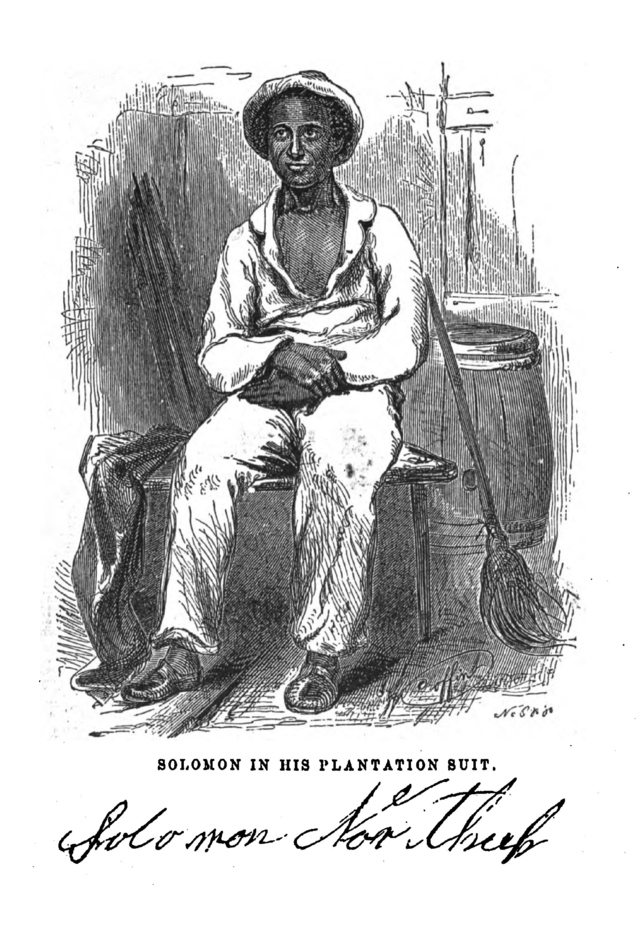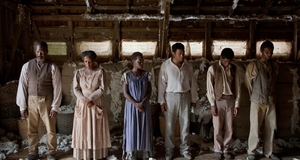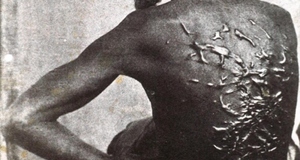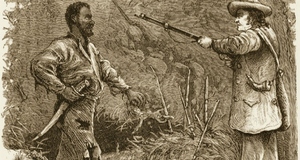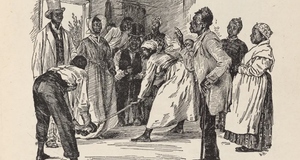Creating Life Within the Confines of Slavery: Comparing Northrup's Memoir Twelve Years a Slave and Genovese's The World the Slaves Made
By
2016, Vol. 8 No. 09 | pg. 1/1 Solomon Northup’s Twelve Years a Slave (1853) provides a comprehensive first-hand account of slavery that both corroborates and challenges Eugene Genovese’s argument in his later analysis of the institution of slavery in The World the Slaves Made (1976). Genovese’s description of slaves’ recognition of their situation is reflected in Northup’s picture of slavery. By the same token, resilience and determination to live life as fully as possible – despite the narrow confines to which life was restrained by the slaveholding institution – is epitomized in Northup’s memoir. One of Genovese’s principal observations, namely that slaves’ resolved to survive and create lives for themselves in spite of striking adversity, is echoed throughout Northup’s memoir. These two works reveal the ways in which the institution of slavery, grounded in the chattel principal, was both brutally simple and subtly complex at the same time. While Northup’s account corroborates some of Genovese’s claims, juxtaposition of these two readings also reveals a striking contrast in the depiction of slavery. This foundational chattel precept invested human beings with the lawful characteristics of property: in essence, slaves were considered property.Though the slave market was the second largest industry in the south, and in spite of its enormous influence over slave life, Genovese fails to fully heed the importance of this trade: he misjudges slaves’ reactions to the loss of their loved ones within the cruel machinations of the market. In contrast, Northup faithfully portrays the effects of this market on slavery, thereby imparting one of the heaviest tolls of slave life to the reader. Furthermore, another area in which Northup and Genovese markedly differ is the family. Northup attributes importance to the family unit, whereas Genovese somewhat dismisses the notion of family’s significance in slave life. The slaves of the American South struggled to make livable worlds for themselves within the narrowest living space and the harshest adversity imposed on them by the slaveholding institution. Though Northup’s and Genovese’s accounts differ in the extreme when concerning family, their principles relatively align with regard to slaves’ determination to carve out meaningful lives for themselves.
Genovese tries to understand the slaves’ attempt to survive spiritually and physically. For instance, slave parents would often inculcate in their children strict discipline and teach them to keep their mouth shut. In so doing, slaves imbued their children with a realist’s outlook, equipping them with the necessary skills for their survival. Essentially, slaves trained their children to survive in a dangerous world, placing a strong emphasis on “courtesy and deference to adults” (Genovese, 512). In addition to these methods for survival, the slaves taught their children how to live their lives as fully as possible. As noted by Genovese:
Genovese places an emphasis on their struggle to make livable worlds for themselves within the narrowest living space and the harshest adversity. Thus, he manages to see past the victimization model, seeing the world that the slaves created for themselves despite everything they were up against and had no control over. Likewise, Northup’s account manifests this undying resolution to live their lives despite hardships, particularly by acting judiciously before others and their masters. For instance, Solomon tentatively contemplates confiding in Mr. Bass, a white carpenter employed on Master Epps’ farm: “My previous ill-fortune had taught me to be extremely cautious. It was not my place to speak to a white man except when spoken to…” (Northup, 208). Northup behaves with tact, recognizing his place within this vile system of slavery and exercises extreme caution as an act of self-preservation. The theme of discretion is raised again when Northup repeatedly conceals his history as a free man and his intellectual cunning in order to survive:
In effect, Solomon had learned to think like a realist, recognizing the potential ramifications of talking too much. Accordingly, he grows wiser and shrewdly remains silent when it serves his best interests. Holistically speaking, Solomon acts in ways that maximize his self-preservation. Solomon adjusts his behavior in order to protect himself and to outwardly exude deference and meet the master’s expectations. For example, Solomon reflects on his plan for survival:
In this case, recognizing that he is both human and vulnerable, Solomon plays this role as a form of self-protection, modifying his attitude in order to please his master. He behaves cleverly, accepting his unwelcome situation in order to survive. Northup further expounds upon his behavior, stating, “Ten years I was compelled to address him with down-cast eyes and uncovered head – in the attitude and language of a slave” (Northup, 138). Northup concedes a degree of acceptance and compliance, not out of free will but, rather, because there exists no other choice. Accordingly, his behavioral mold, grounded in respect for the master, aligns with the code of conduct necessary for survival. Of note, Northup’s actions sometimes do not reflect Genovese’s notion of slaves’ reverence towards their master as a means for survival– specifically when Northup springs upon his master Tibeats:
Northup in no way acts respectfully towards Tibeats. In contrast, he behaves quite aggressively towards his master, grabbing him by the throat and threatening with suffocation. Throughout this scene, Solomon is motivated by the will to survive. Although he does not try to please his master in order to do so, Solomon, nevertheless, clearly values his life, going to this extreme in order to preserve himself. Whereas displaying reverence may have been a successful tactic with other masters, in this case such a survival strategy would have been rendered futile, given Tibeats’ volatile nature. This aforementioned scene speaks to a much larger theme of variety among masters, which redounds to the complexity of the slave system itself. Genovese and Northup’s accounts both acknowledge the wide range of masters within the system of slavery. For example, Northup characterizes Master Epps as a brutal master, gratuitously whipping his slaves and forcing them to dance:
Epps is undoubtedly a man with “a rough, rude energy…and an avaricious spirit” (Northup, 138). He delights in whipping his slaves and inflicting pain upon them. His evil disposition is starkly contrasted by the compassionate demeanors of Master Ford. For example, Solomon opines on his time working under Master Ford: “During my residence with Master Ford I had seen only the bright side of slavery. I think of him with affection…” (Northup, 74). This passage betrays Northup’s emphatic attribution of an inherent goodness to Master Ford. Later on, Master Ford is placed on an even greater pedestal when he allows Solomon to take refuge in his home and eschew Tibeats’ wrath. As evidenced, a variety of portrayals of masters abounds, thereby buttressing Genovese’s notion of the dynamic and complex nature of slavery. In essence, slavery could vary enormously on adjoining properties, depending on the master. Both authors acknowledge that slavery was rooted in the chattel principle, whereby slaves were deemed property. Genovese overtly states, “Slavery rested on the principle of property in man – of one man’s appropriation of another’s person as well as of the fruits of his labor” (Genovese, 3). Whites essentially treated their slaves as items to be purchased and sold. This outlook is frequently exemplified throughout Northup’s memoir, even from the very outset. For example, when Solomon Northup is taken and sold into slavery, he is first placed in “William’s Slave Pen” (Northup, 28). The very name of this place immediately attributes a savage, inhuman quality to the slaves. They are essentially regarded as hogs in a pen. This relegation from human to bestial status not only degrades slaves but implies that they are less than human – merely assets to be arbitrarily traded. Subsequently, this principle features prominently in the text when Solomon falls ill and is reluctantly taken to see a doctor: “When it was said that I would die, Master Epps, unwilling to bear the loss, which the death of an animal worth a thousand dollars would bring upon him, concluded to incur the expense of sending to Holmesville for Dr. Wines” (Northup, 134). This example serves as a poignant illustration of the way in which slaves were treated. Slaves are repeatedly likened to livestock by their masters, and, as evidenced, decisions made by a master are predicated upon the slave’s value as a piece of property. In this case, Master Epps unenthusiastically acquiesces to having Solomon examined by a physician, solely because the former did not want to damage his own economic standing and interests. Slaves were considered valuable property, and letting them die would incur enormous losses for a master. Thus, Solomon’s status as a human being is denied, as the master only considers the price tag on the former’s forehead when deliberating matters. This chattel motif is further alluded to throughout the memoir, particularly when Northup describes Epps’ percepts:
In this example, masters’ opinions regarding the slaves is explicitly divulged, and the chattel principle is stated in overt terms. Later, Northup reiterates Epps’ attitude, stating that Epps viewed the slave as “an animal” (Northup, 201). In essence, to be a slave is to have one’s self-worth equated to that of a “mule or dog.” Slaves are branded inferior, dependent beings lacking human characteristics. Lastly, the way in which Theophilus Freeman, a slave trader, talks about his slave serves as a testament to the transcendent belief that slaves were possessions imbued with economic value. In particular, Freeman, in response to an inquiry regarding sale, would not “sell her then on any account whatever. There were heaps and piles of money to be made of her…when she was a few years older” (Northup, 58). Ultimately, through Northup’s passage, one can glean that profit and slaves were inextricably intertwined from the perspective of masters and traders. Holistically, slavery was a complex money-making business entrenched in the idea that slaves are lucrative paraphernalia. Accordingly, one can construe a salient correspondence between the estimations of both Genovese and Northup with respect to the slaves as chattel. Interestingly, Genovese propounds a theory of acceptance with regard to parents being separated from their children. He mistakenly diminishes the value of family to the slaves, particularly parents in relation to their children, as he states,
Genovese erroneously assumes that slaves accepted their separation of loved ones and did not harbor bitterness or resentment. In contrast, quite the opposite is illustrated through Northup’s account. When Eliza, a female slave on Ford’s plantation, is separated from her daughter, who is sold, she is deluged by an eternal wave of grief. Repeatedly throughout the memoir, Northup comments upon Eliza’s deteriorating mental and physical condition owing to the breaking apart of her family. For instance, Eliza cries incessantly and bemoans the parting from her children, particularly in the following passage: “All the time the trade was going on, Eliza was crying aloud, and wringing her hands…then Eliza burst into a paroxysm of grief, weeping plaintively…She wanted to be with her children, she said, the little time she had to live” (Northup, 54-55). Eliza here is unquestionably afflicted and beset by an an inexhaustible tempest of anguish. This grief stems from an unconditional love for her children and the utter impossibility of happiness without them. This example not only illustrates the great extent to which the slave market and sales destroyed families but also the magnitude of family members’ love for one another. Such a visceral outcry would not have been elicited had the mother not genuinely adored her children. Thus, Genovese grossly underestimates familial affection of slaves as well as the acute responses of slaves in the wake of the family separation. The severance of familial ties was by no means a process that slaves reacted to with less than full-blown grief. Further testament to the supreme impact of separation on families is revealed when Eliza passionately hugs her boy before saying good bye, “All the while her tears falling in the boy’s face like rain” (Northup, 54). Clearly, such farewells were anything but equanimitous affairs marked by acceptance. Solomon additionally comments upon this grievous occasion, belaboring the point that slaves were, indeed, viscerally shaken to their core by family separation: “…never have I seen such an exhibition of intense, unmeasured and unbounded grief as when Eliza was parted from her child…she only clung closer to the child” (Northup, 57). Here, Solomon evinces feelings of grief that know no bounds and rules out any suppositions of acceptance. By the same token, Eliza beseeches her master to exhibit clemency, attempting to evoke pathos: “‘Please, master, buy Emily. I can never work any if she is taken from me; I will die” (Northup, 58). In response to losing both Emily and Randall, Eliza is utterly abject and feels as though her life is no longer worth living. Such a statement confirms the notion that slaves did not accept these losses as simply a fact of life. Rather, these tragic events marked moments of profound grief, which were often never accepted by slaves. In addition, Northup notes that a sense of pervasive hatred compounded with the despair that accompanied the separation of families, specifically when describing Eliza: “She weepeth sore in the night, and tears are on her cheeks: all her friends have dealt treacherously with her: they have become her enemies” (Northup, 61). The very implication of Eliza’s masters as her enemies dispels the idea that slaves did not experience hatred towards them. Here, Northup clearly opposes Genovese’s claim that “slaves did not necessarily hate their individual masters,” as he describes Eliza as blatantly viewing them as her foes. Therefore, the slaves did not accept the sale of their loved ones “however much they suffered,” but rather harbored enduring odious sentiment towards them. Furthermore, Genovese overlooks the fundamentally influential impact that the slave market had on slave life, giving it short shrift. Unlike Northup, Genovese doesn’t pay adequate attention to the slave trade. He does not give the reader a sense of the vulnerability of the slaves. Genovese provides an unrealistic sense of where things stood in the Late Antebellum period, an age of remarkable boom in slave market. Essentially, Genovese failed to recognize that there existed a constant temptation to take profits from the slave trade, even at the expense of breaking up families. Masters, in their own self-interest, encouraged the creation of slave families but they could also break them apart. Conversely, Northup clearly discloses the undeniable sway in which the slave market governed the lives of slaves. For example, when Eliza is delivered into the hands of Burch, a slave trader, and subsequently sold, her life comes to a halt. A bill of sale is signed and she is consigned to a dreary fate, upon which Northup comments, “The hope of years was blasted in a moment. From the height of most exulting happiness to the utmost depths of wretchedness, she had that day descended…How all her fears were realized…how, as she predicted, her heart did indeed break with the burden of maternal sorrow…” (Northup, 32). As evidenced by this passage, the threat of sale was very real and frighteningly imminent, capable of rendering slaves broken and inconsolable. This example not only reveals the chronic threat of sale that loomed over slaves’ heads but also shows how this trade could, in an instant, break up families. Ultimately, the slave market proves to be a formidable force, extraordinarily officious and capable of dispassionately wresting slaves from the arms of their loved ones. This aforementioned passage regarding Eliza also speaks to the supreme importance of family, which Genovese ignores. Whereas Genovese does not stress family’s fundamental importance, Northup provides trenchant insight and places sufficient emphasis on the family unit as the center around which slave life revolves. Throughout his memoir, Northup continually invokes this aforesaid theme of fear of sale. Genuine maternal affection is revealed through Eliza’s suffering ensuing her children’s sale. The assumption that familial affection was not present is blatantly refuted, as authentic emotion is evinced through slaves’ actions throughout the memoir. Demonstration of a mother’s universal and inherent doting and concern crystallizes the idea that family forms the crux of slave life. For example, when Eliza and her children are sequestered in a slave pen, this sense of eternal compassion verily surfaces:
Eliza’s touching caresses and soothing words manifest an undying tender devotion to her loved ones. By virtue of her doting actions, one can intuit that the devotion to one’s loved ones decidedly materializes in this passage. Moreover, the extent to which slave parents care for their children is enormous, and proper attention to an affectionate family life is verily heeded by Northup, in contrast to Genovese. In conclusion, Northup’s Twelve Years a Slave simultaneously buttresses and repudiates the arguments propounded by Genovese in The World the Slaves Made. Genovese and Northup identify a sort of situational recognition amongst the enslaved, given their circumstances, and their resulting determination to survive and create meaningful lives in the face of this adversity. At the same time, the varying characterizations of slave masters throughout Northup’s memoir elucidate the terrible subtleties of the slave system and the ways in which the chattel principle formed the foundation of slave life. Nevertheless, the depiction of slave life differs in certain areas among these two accounts. While Genovese overlooks the slave trade and places insufficient weight upon the sale of loved ones, Northup relays a more telling and perspicacious account. Lastly, the central importance of family to slave life is superlatively embodied in Northup’s memoir, whereas Genovese falls short in that respect. ReferencesGenovese, E. D. (1976). Roll, Jordan, roll: The world the slaves made. Vintage. Northup, S., Eakin, S. L., & Wilson, D. (1853/2013).Twelve years a slave. Penguin books. Suggested Reading from Inquiries Journal
Inquiries Journal provides undergraduate and graduate students around the world a platform for the wide dissemination of academic work over a range of core disciplines. Representing the work of students from hundreds of institutions around the globe, Inquiries Journal's large database of academic articles is completely free. Learn more | Blog | Submit Latest in History |

